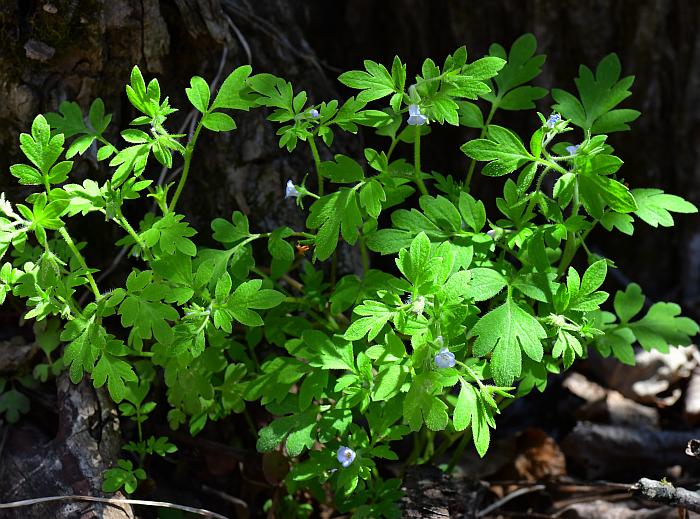Phacelia covillei S. Watson
Coville's Phacelia

Native
CC = 8
CW = -3
MOC = 2
SRank = S1
© SRTurner
Phacelia covillei S. WatsonCoville's Phacelia | |
 |
Native CC = 8 CW = -3 MOC = 2 SRank = S1 |
© SRTurner |
|
Family - Hydrophyllaceae Habit - Slender annual forb with fibrous roots.
Stems - Weakly to strongly ascending, to 30 cm, usually branched, sometimes from a spreading base, moderately pubescent with stiff, loosely ascending, nonglandular hairs toward the base, these grading into dense, shorter, gland-tipped hairs toward the tip, the median portion with mostly nonglandular hairs.
Leaves - Alternate, irregularly pinnately compound. Basal leaves often persistent at flowering, the blade 1-3 cm long, broadly ovate to broadly elliptic or oblong-elliptic in outline, pinnately compound with 3-7 pinnae, these unlobed or (especially the terminal pinna) mostly moderately to deeply 2-or 3-lobed and sometimes also with a few additional teeth or smaller lobes, the teeth or lobes sharply to bluntly pointed or occasionally rounded at the tips, the surfaces sparsely to moderately pubescent with more or less appressed, stiff hairs. Stem leaves all moderately to long-petiolate, the blade 1-4 cm long, progressively less divided toward the stem tip, the uppermost leaf blades often irregularly 3-lobed, the leaflets or lobes sharply to bluntly pointed or occasionally rounded at the tips, the terminal lobe of at least the uppermost leaf (immediately below the lowermost flower) narrowly angled or cuneate at the base, the pubescence similar to that of the basal leaves.
Inflorescences - Open racemes with 2-6 flowers, the axis and flower stalks densely glandular-hairy, sometimes also with scattered nonglandular hairs, the stalks spreading to downward-arched or pendent at fruiting.
Flowers - Calyces 3-7 mm long, the 5 lobes with the margins and surfaces pubescent with mostly nonglandular hairs, with glandular hairs more frequent at the calyx base. Corollas 2-5 mm long, narrowly bell-shaped to nearly cylindrical, nearly white to light purple, the margins entire, the outer surface glabrous. Stamens 5, not exserted, the filaments 1.5-2.0 mm long, glabrous. Ovary with 4 ovules. Style branched to about the midpoint.
Fruits - Capsules 4-6 mm long, longitudinally dehiscent, the surface hairy, usually irregularly swollen (distended by the seeds), 2-4-seeded. Seeds 2.0-2.5 mm long, broadly ovoid-angled to nearly globose, finely ridged, brown.
Flowering - April - May. Habitat - Bottomland, mesic, or upland forests. Origin - Native to the U.S. Lookalikes - Closely resembles P. rancunculacea. Other info. - This is a rare species. In Missouri it is known from only two counties, and its global distribution is restricted to a few similarly small areas in states to the east of Missouri. The plant is inconspicuous and closely resembles its lookalike, P. ranunculacea, so it is possible that some populations have been overlooked. It is distinguished from its lookalike by having upper leaves which are tapered and wedge-shaped at the base, rather than rounded, and by having mostly nonglandular, somewhat stiff, and generally upward-pointed hairs along the middle of the stem. The species can sometimes be found on upland forested ridges, in a somewhat drier habitat than that favored by the lookalike. A common associate is Ranunculus harveyi, which suggests a preference for acid substrate. Photographs taken near the Bald Ridge Creek, Pulaski County, MO, 4-19-2021, and near the Paddy Creek Campground, Texas County, MO, 4-19-2021 (SRTurner). |